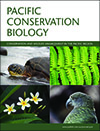We used data from long-term records (1989–2020) of the Friends of the Koala in north-east New South Wales to identify trends in 5051 koala admissions. Chlamydiosis was the main cause of admission. Overall, 35% of admitted koalas were released. We have provided a new outlook on the limitations and strengths of rehabilitation records for koala conservation.

Volume 29 Number 3 2023
We asked: will a koala released from rehabilitation re-join the wild population and survive? Using ear tag records, we sifted the 31-year set of 5051 koala admission records. Re-admission figures mostly fitted the pattern of first admissions, meaning that the released koalas had become part of the local koala population. Of the 270 koalas that were re-admitted into rehabilitation, 66% remained for more than 6 months in the wild. We conclude that rehabilitated koalas can survive long term in the wild.
Bird species composition in Fiji is shown to significantly differ between grasslands and forests. However, no significant differences were observed between three forest types: primary, old regrowth, and mahogany plantation. Forest cover therefore is important for the conservation of native Fijian bird species and can be provided by regrowth.
PC21039 Abstract | PC21039 Full Text | PC21039PDF (2.6 MB) Open Access Article
PC21027Benthic foraminifera as bioindicators for assessing reef condition in Kāne‘ohe Bay, O‘ahu, Hawai‘i
Using benthic foraminifera to assess water quality in Kāne‘ohe Bay, Hawai‘i, we found a clear and robust spatial pattern for reef suitability in Kāne‘ohe Bay, with areas closer to the shore and especially closer to Kāne‘ohe City being less suitable, while samples from the northern bay area indicated conditions more suitable for reef growth and recovery.
PC21027 Abstract | PC21027 Full Text | PC21027PDF (926 KB) | PC21027Supplementary Material (1.4 MB) Open Access Article
PC21075Monitoring threatened palm populations: a case study of three narrow endemic species of New Caledonia
New Caledonia is home to an extraordinary assemblage of endemic and, in most cases, endangered palms. We evaluated the population structure of three endangered, narrow endemic palm species, Burretiokentia koghiensis, Cyphophoenix nucele, and Chambeyronia houailouensis, to better understand the factors responsible for endangerment and how best to devise and prioritise actions to conserve these palms.
PC21068Effects of an island-wide rodent eradication programme on two threatened bird species
Few studies have quantitatively measured the ecological effects of rodent eradications on native species and ecosystems. We found that many currawongs disappeared during the Lord Howe Island rodent eradication but breeding success was unaffected. In contrast, white tern breeding success remained poor. Our study has emphasised the necessity of ecological monitoring as part of rodent eradications on islands.
PC21068 Abstract | PC21068 Full Text | PC21068PDF (1.6 MB) Open Access Article
This review looks critically at the way the status of species is assessed. The current approach based on IUCN criteria is reactive when it should be proactive and include species that have or are increasing in abundance. Nonetheless, the 2020 Action Plan is an important report and will be used to promote the conservation of Australian birds.




